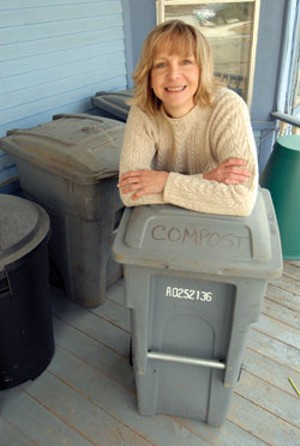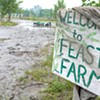Published April 16, 2008 at 11:40 a.m.
Just outside downtown Montpelier, at 137 Barre Street, sits an elegant, baby-blue 1898 Victorian with a rickety porch. The building looks like a home, but a sign beside the doorway reads, “Central Vermont Solid Waste Management District.”
In the kitchen, just above the coffee maker, a small paper note has been tacked to a cabinet. “Your mother does not work here,” it reads. “Please pick up after yourself.” It’s a subtle reminder that the mother of all mothers — the planet Earth — can’t continue to absorb the byproducts of today’s consumer-driven society, and that Vermonters should be taking a more critical look at their consumption patterns.
Indeed, the average Vermonter produced about a ton of municipal solid waste in 2005, more than two-thirds of which was stuffed into state landfills or incinerated. As the state’s second-largest solid waste management district, CVSWMD is charged with reducing that mountain of refuse by helping its 60,000 customers — homeowners, businesses and schools — better manage their garbage and recycling.
Since 2001, CVSWMD has sought to go one giant step further by pursuing a strategy aimed at not just reducing the district’s solid waste, but eliminating it all together. That makes CVSWMD the only waste-management district east of the Mississippi, and one of the largest in the country, with a “zero waste” plan.
While the goal is daunting, the theory behind zero waste is simple: By finding new uses for many of the items that end up in landfills — metal, electronics, furniture — communities can shrink their environmental footprints, save money and create new, “greener” industries built on the recovery of everyday waste. Earlier this month, zero waste topped Newsweek magazine’s list of the 10 top “fixes for the planet.”
Since launching the initiative, CVSWMD has sponsored periodic waste collection days for “electronic waste,” paint and batteries. The district is also helping schools, businesses and residents compost their food scraps, rather than tossing them in the trash. And a “biosolids” committee is currently setting up a program for the safe disposal of unwanted medication.
At this stage, says CVSWMD Executive Director Donna Barlow Casey, there is no data available to document the progress of the campaign, which is still in “vision process” mode. But Barlow Casey, 52, claims central Vermont is an ideal place for a zero- waste initiative.
For one thing, most of the state’s big environmental groups are headquartered down the road from the district’s headquarters. One of them, Toxics Action Center, was a key partner during the early planning stages. Another, the Vermont Public Interest Research Group (VPIRG), has lobbied for “e-waste” legislation that CVSWMD supports.
Since 2004, nearby Vermont Compost Co. has been turning food scraps from Montpelier High School into compost, which students use to seed lettuce in a school greenhouse. Tom Sabo, a young biology teacher who oversees the process, says it helps students understand how “waste equals food.”
That’s the idea, notes Barlow Casey on a recent afternoon in her office kitchen. “If we create a society in which it’s commonplace to accomplish this work, then children will automatically be raised to [compost],” she asserts. “That’s better than telling them to do something that adults aren’t doing.”
But not everyone in the solid-waste world is keen on the zero-waste idea. Tom Moreau, general manager of the Chittenden Solid Waste District (CSWD), agrees that Vermont needs to throw out less, but suggests Barlow Casey’s plan is lean on practical solutions.
Moreau’s district, serving more than 150,000 customers, is the largest in the state. It has been a major bankroller of sustainable initiatives since 1987, including providing early backing for Intervale Compost Products. The Chittenden district resells the bulk of the used paint it recovers, and it subsidizes collection of used compact fluorescent bulbs. It also operates six “ReUse Zones,” where residents swap items such as furniture, bikes and books.
Moreau takes issue with CVSWMD’s reliance on grant funding, as opposed to the more sustainable business models, to accomplish its goals. Ultimately, Moreau says, it’s results that count, and Barlow Casey has yet to produce any.
“Zero-waste advocates,” Moreau says, “lack some real-world, putting-it-on-the-streets experience.”
While she shares the same job title as Moreau, Barlow Casey takes a different approach to solid-waste management. Formerly in marketing, she’s wary of using industry-speak to bring about change in consumer-behavior patterns. Instead, she bases her outreach on theories gleaned from pop-sociology treatises such as Malcolm Gladwell’s The Tipping Point: How Little Things Can Make a Big Difference.
Her staffers are a creative bunch. Cathy Donohue, CVSWMD’s communications manager, is a freelance editor. Dennis Sauer, who used to run the recycling program, is a former organic farmer. “You don’t need a bureaucrat to invent a cutting-edge organics program,” says Barlow Casey, who favors orange shoes and dangly earrings. “You need somebody who’s able to take risks, but be orderly and have good attention to detail.”
The state of Vermont is getting on board. For the first time in 20 years, lawmakers are preparing to review the state’s solid-waste priorities. The Agency of Natural Resources (ANR) is in the midst of creating a “Center for Climate Change and Waste Reduction.” But Barlow Casey claims state and local governments should be pushing more “front end” solutions to waste problems. That could include something called “extended producer responsibility,” levying higher trash-disposal fees on manufacturers and businesses as an incentive to demand more reusable, or at least better-made, goods from suppliers.
In the meantime, “zero waste” is catching on by degrees. In 2006, CVSWMD created the first inter-district partnership with nearby Northeast Kingdom Waste Management District. With a grant from the USDA, the two districts are composting together at the Highfields Institute in Hardwick. NEKWMD is also distributing “green cones” — residential compost receptacles first introduced by Barlow Casey’s district in 2005.
Zero waste campaigns are long overdue, says NEKWMD Executive Director Paul Tomasi. “A lot of people say, ‘Well, zero waste is just pie-in-the-sky, you’ll never get there,’” Tomasi says. “But the question becomes, ‘What level of waste are you comfortable with?’”
On a recent evening at Vermont College in Montpelier, Gary Liss, founder of the National Recycling Coalition and a world-renowned zero-waste consultant, put that very question to about 30 local residents.
“Zero?” a few people said.
“How much waste are you for?”
“Zero,” they repeated.
“I don’t think the students out there heard you,” replied Liss, a short, skinny man whose suit was too big for his body. “How . . . much . . . waste . . . are you for?”
“ZERO!”
Liss smiled. “That’s what we call the force of zero. And it’s with us.”
And not a minute too soon, apparently. Vermont’s two major landfills, in Coventry and Moretown, already collect over half a million tons of trash each year. Meanwhile, methane gas, a major landfill byproduct, is busy aiding and abetting global warming. And, contrary to the state’s green reputation, Vermont diverts less of its solid waste from landfills and incinerators than the nation’s average diversion rate.
Despite fierce opposition from a grassroots citizens’ group, Moreau and the Chittenden district want to address the problem in an old way — with a new landfill in Williston. For Moreau, who testified on compost legislation last week at the Statehouse, the facility represents the kind of real-world solution that zero-waste advocates will never understand.
Barlow Casey, for her part, contends that Moreau doesn’t understand the “creative” approach to solid-waste management. Although it’s “softer” than what Moreau is used to, Barlow Casey believes her approach will eventually produce a sea change in consumption patterns — and that, someday, she’ll have the hard data to prove it.
“A real-world solution is not a solution that pollutes, changes the climate and wastes resources,” she says. “That’s an old-world solution — a world, we’ve learned already, that is not working.”
More By This Author
Speaking of...
-

In Montpelier, Enna to Serve Gelato; Dairy Creme for Sale
Apr 30, 2024 -

Q&A: Downtown Montpelier Transforms Into PoemCity Every April
Apr 24, 2024 -

Video: Visiting the Kellogg-Hubbard Library’s PoemCity in Montpelier During the Month of April
Apr 18, 2024 -

Ondis Serves Seasonal Fare With a Side of Community in Montpelier
Apr 16, 2024 -

Totally Transfixed: A Rare Eclipse on a Bluebird Day Dazzled Crowds in Northern Vermont
Apr 10, 2024 - More »
Comments
Comments are closed.
From 2014-2020, Seven Days allowed readers to comment on all stories posted on our website. While we've appreciated the suggestions and insights, right now Seven Days is prioritizing our core mission — producing high-quality, responsible local journalism — over moderating online debates between readers.
To criticize, correct or praise our reporting, please send us a letter to the editor or send us a tip. We’ll check it out and report the results.
Online comments may return when we have better tech tools for managing them. Thanks for reading.













































